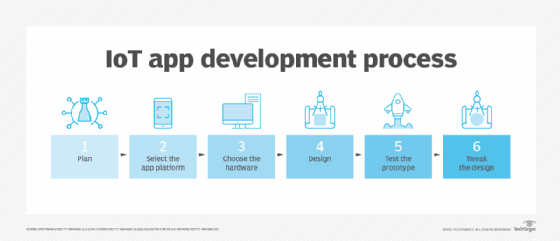
Getty Images/iStockphoto
6 steps to kick-start IoT app development
IoT app development teams must tackle the nuances of IoT technology in the planning and design phases of development, including IoT security vulnerabilities and compatibility.
If organizations want to create the best possible customer experience for their IoT product, their IoT team must often develop their own app to accompany it.
Internal IoT app development gives development teams more granular control than prebuilt options or hiring a third-party provider. Control over every aspect of the process can lead to higher overall quality.
As IoT app development grows with adoption, organizations might find it more difficult to hire external developers with enough experience to do the job within the needed time frame. The high demand for IoT expertise has made it harder for organizations to close the skills gap and hire outside experts. This demand has also led to a rise in the adoption of no-code and low-code development platforms for IoT apps.
Each of these reasons contributes to an organization choosing to build an IoT app internally, even without in-house programming expertise.
What components make up an IoT application?
Regardless of the industry, IoT applications have specific parts:
Sensors or endpoints. Sensors capture electrical or analog signals that are sent through the rest of the system. Depending on an application's purpose, sensors may gather data about environmental factors -- such as temperature, movement or light -- and send the information to the application.
Connectivity and network layer. Data from an IoT system gets sent to the cloud or a dedicated interface for processing and review. The connectivity layer transmits the information to the destination through a router, gateway or Ethernet cable. Some IoT applications also rely on cellular networks, Wi-Fi or Bluetooth.
Software. Software processes the data once it reaches the cloud. It also verifies whether the information falls within specific parameters.
User interface. A person uses the interface of an IoT app to receive, interact with and personalize data. A user might set an application for the IoT sensors on critical equipment to give a notification when the temperature rises above a specific degree. The application may also have analytics features that bring context to the gathered data for users to understand and act upon the insights. According to a survey by Redpoint Global and The Harris Poll, 63% of consumers expect personalization as a standard of service. Personalization in an application can require more customized app development to integrate machine learning algorithms that learn from user activity.
What are the challenges of IoT app development?
Every development project comes with technology-specific considerations. For IoT app development, many challenges stem from the differences between IoT and the traditional technologies, such as PCs and smartphones, that use web or mobile apps. IoT devices have less in-device computing power and storage than these other technologies. App developers must consider these limitations and how they will influence the interaction between applications and the IoT devices. For example, latency may increase because data takes more time to transfer from a remote device to the cloud and then undergo processing.
Far too often, developers consider IoT security as an afterthought, which means problems are often discovered after an application is already in use. Such instances could put users or the public at risk. Encryption protocols, user authentication options and thorough testing can help make an IoT application as secure as possible.
In addition to IoT app security, developers must consider data security. For example, developers should know when an application will collect data, and where that information goes once generated. If the application's content relates to a mission-critical or confidential business operation, it's especially important to keep it safe from unauthorized parties.
Developers must also strive to make the app user-friendly and stay mindful of its purpose. For example, the user-facing parts of an application would vary depending on if the product is a smart insulin pump or a temperature monitor for an industrial freezer.
Compatibility with various brands is a concern, primarily if an organization wants to build an app for consumer use. If a business creates a smart home hub application, the developers must consider how someone with an iPhone or Android will connect to the hub and ensure the application still works.

Steps and considerations to create IoT applications
The process to build an IoT application depends on numerous factors, such as the organization's budget and overall timeline. However, here are some of the most common steps and associated considerations:
1. Hold the initial project planning meeting
The planning phase irons out the project's goals and objectives. The questions asked during this period should balance the company's needs, such as budget and timeline, with those of the application's users, such as functionality and ease of use.
2. Select the app development platform
Organizations have a wide variety of platforms to choose from, including no-code and low-code. Developers select different platforms to connect products into a single system. For example, Google's IoT platform supports low-energy sensors and other products from manufacturers.
3. Choose the hardware
If IoT app developers don't build the hardware internally, they must take the time to select a reputable vendor to handle that need. Reliability and connectivity are two main concerns for ensuring the application works as intended.
4. Begin the design phase
Developers should prioritize speed and performance when participating in the design process. Many IoT applications collect data in near real time. Even a lag of several seconds could be too long for some use cases. Security must also be a top concern during design and will reduce the chance of problems occurring later.
5. Test the prototype
Testing a prototype is a critical part of IoT app development because it reveals real-world feasibility and gives organizations a chance to work out any issues before the application is in consumers' hands. Developers can also check for compatibility issues between different vendor products and software.
6. Tweak the design based on testing
Even the most well-thought-out designs will likely need changes after testing occurs. This is not a sign of development team shortcomings but merely a reflection of the reality that issues typically arise when people use the app. That's because testers often interact with the app in ways the developers did not think of at the start.








